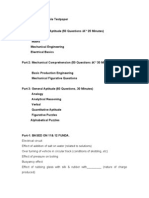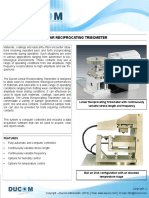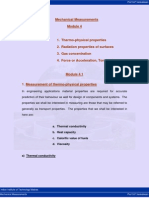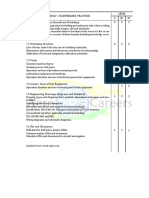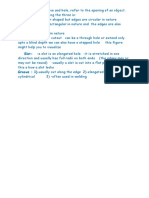Method of Checking Shafts
Uploaded by
RAJ MOHANMethod of Checking Shafts
Uploaded by
RAJ MOHANStandard methods for checking shafts,
Ovality ;
This usually occurs as a result of the surface wearing, through friction or linear movement.
Ovality and can apply equally to holes and shafts .Holes may be tested for ovality, using such
instruments as Go/No-Go gauges,internal micrometers, or callipers, as were previously discussed in
the Tools topic
of this course.
A shaft may be tested for ovality, by the use of snap gauges, external calipers and
micrometers.
It is important to test for ovality of a shaft, before testing it for bow, as the results may
be suspect if bow is done first.
Bow in a shaft can be determined, in a workshop, by utilising V blocks, a surface
gauge and a DTI (in conjunction with a surface table).
When dealing with shafts and tubes, it is vital that not only are the ends square with
each other, but that the centreline of the complete shaft or tube is straight.If the centre line of the shaft
is not straight, then the item is bowed.
When the shaft or tube is rotating, especially at a high speed in a bowed state, there is
the risk of vibration, which can lead to mechanical failures, loosening of fasteners and (most critical of
all) fatigue.
Bores/ holes.::
1. Where holes found to be elongated by stress the part must be renewed.
2. The corresponding pin or bolt assemblies should be inspected for wear, distortion, Picking up
& shear, and where necessary renewed.
3. Lubricating ducts should be inspected for obstruction.
4. When excessive wear has taken place in unbushed holes , the fitting should be renewed .
5. Wear in ball and roller bearing should be checked.
Twist/Bow
1. Measurement of bow in a structural member using a straight edge and a set of feeler gage,
providing the part to be measured is free from protruding fittings and straight edge can be
applied directly along the surface of the member.
2. The straight edge placed along the entire length of the member and parallel to it’s axis , then
inserting the filler gage at the point of maximum clearance .
3. The amount of bow can be calculated by the formula
Bow = clearance measured by Feeler gage
Length of member
You might also like
- Metrology & Measurements University Question PapersNo ratings yetMetrology & Measurements University Question Papers22 pages
- Answer-Keys Applied Mechanics For Engineering Technology - K. M. WalkerNo ratings yetAnswer-Keys Applied Mechanics For Engineering Technology - K. M. Walker22 pages
- Ae 1254 - Aircraft Structures - 1: Two Mark Question & AnswersNo ratings yetAe 1254 - Aircraft Structures - 1: Two Mark Question & Answers21 pages
- 50 TOP ELECTRONIC INSTRUMENTS Questions and Answers PDFNo ratings yet50 TOP ELECTRONIC INSTRUMENTS Questions and Answers PDF6 pages
- Modeling & Analysis Lab Manual - 15ael77: Vii SemesterNo ratings yetModeling & Analysis Lab Manual - 15ael77: Vii Semester27 pages
- Introduction To Structures & MechanismsNo ratings yetIntroduction To Structures & Mechanisms55 pages
- Mos Lab Internal Question Paper II Year A & C SectionNo ratings yetMos Lab Internal Question Paper II Year A & C Section2 pages
- CH 6 - Straightness, Flatness and Roundness-P1No ratings yetCH 6 - Straightness, Flatness and Roundness-P112 pages
- AE 424 PPT 2.2 Physical CharacteristicsNo ratings yetAE 424 PPT 2.2 Physical Characteristics48 pages
- Module 5 - Digital Techniques Electronic Instrument Systems PDFNo ratings yetModule 5 - Digital Techniques Electronic Instrument Systems PDF42 pages
- Torque Defines As A Moment That Tends To Twist A Member About Its Longitudinal Axis - The100% (1)Torque Defines As A Moment That Tends To Twist A Member About Its Longitudinal Axis - The7 pages
- SURVEYING Multiple Choice Questions With Answers PDFNo ratings yetSURVEYING Multiple Choice Questions With Answers PDF30 pages
- Ignition, Injection, Cooling Lubrication and GovernorNo ratings yetIgnition, Injection, Cooling Lubrication and Governor26 pages
- Vibration and Noise Engineering Syllabus PDFNo ratings yetVibration and Noise Engineering Syllabus PDF1 page
- FDM Process Parameters Influence Over The Mechanical Properties of Polymer SpecimenNo ratings yetFDM Process Parameters Influence Over The Mechanical Properties of Polymer Specimen10 pages
- Unit 8 Metrology of Gear and Screw ThreadNo ratings yetUnit 8 Metrology of Gear and Screw Thread27 pages
- Screws, Cap Screws) For Headed, External Screw-Threaded FastenersNo ratings yetScrews, Cap Screws) For Headed, External Screw-Threaded Fasteners35 pages
- 1,2... Material and Hardware PracticalsNo ratings yet1,2... Material and Hardware Practicals17 pages



















